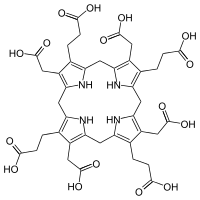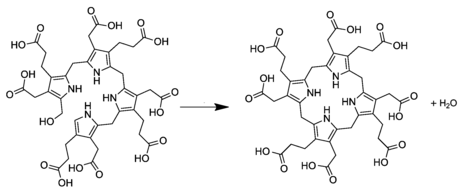Uroporphyrinogen I
Uroporphyrinogen I is an isomer of uroporphyrinogen III, a metabolic intermediate in the biosynthesis of heme. A type of porphyria is caused by production of uroporphyrinogen I instead of III.
 | |
| Identifiers | |
|---|---|
3D model (JSmol) |
|
| ChemSpider | |
PubChem CID |
|
| |
| |
| Properties | |
| C40H44N4O16 | |
| Molar mass | 836.804 g·mol−1 |
Except where otherwise noted, data are given for materials in their standard state (at 25 °C [77 °F], 100 kPa). | |
| Infobox references | |
Biosynthesis and metabolism
In living organisms, uroporphirinogen I occurs as a side branch of the main porphyrin synthesis pathway. In the normal pathway, the linear tetrapyrrole precursor preuroporphyrinogen (a substituted hydroxymethylbilane) is converted by the enzyme uroporphyrinogen-III cosynthase into the cyclic uroporphyrinogen III; which is then converted to coproporphyrinogen III on the way to porphyrins like heme. Uroporphyrinogen I is instead produced spontaneously from preouroporphyrinogen when the enzyme is not present.[1][2]

The difference between the I and III forms is the arrangement of the four carboxyethyl groups (propionic acidd, "P") and the four carboxymethyl groups (acetic acid, "A"). The non-enzymatic conversion to uroporphyrinogen I results in the sequence AP-AP-AP-AP, whereas the enzymatic conversion into uroporphyrinogen III lead to reversal of one AP-group and hence an AP-AP-AP-PA arrangement.
If synthesized, uroporphyrinogen I is then converted into coproporphyrinogen I by the same enzyme (uroporphyrinogen decarboxylase) that acts on the III form; but that product, which is cytotoxic, then accumulates causing the pathology congenital erythropoietic porphyria.[2]
References
- Paul R. Ortiz de Montellano (2008). "Hemes in Biology". Wiley Encyclopedia of Chemical Biology. John Wiley & Sons. doi:10.1002/9780470048672.wecb221. ISBN 978-0470048672.
- Sassa, S.; Kappas, A. (2000). "Molecular aspects of the inherited porphyrias". Journal of Internal Medicine. 247 (2): 169–178. doi:10.1046/j.1365-2796.2000.00618.x. PMID 10692079.
